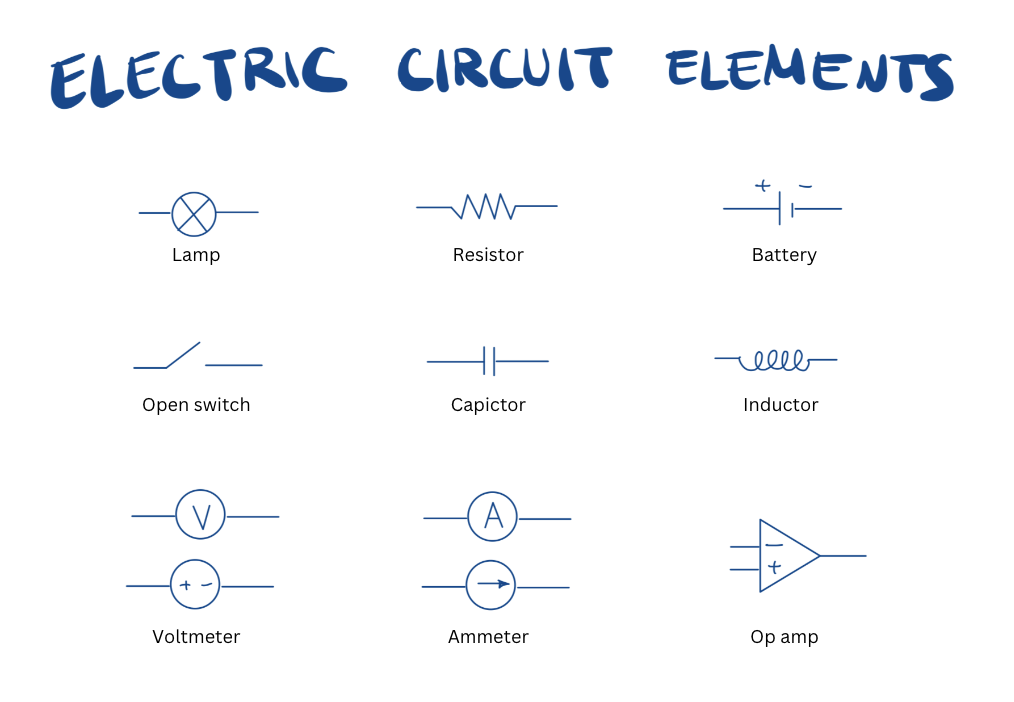When people find out I’m not very good at building circuits, they’re shocked!
Circuits are the building blocks of all electrical devices – including the device on which you’re reading this right now. In EngSci’s introductory circuits course, ECE159, you’ll be introduced to circuit properties such as current, voltage, and resistance, as well as circuit components like sources, resistors, capacitors, inductors, and op-amps. You will learn about DC (direct current) and AC (alternating current) circuits, and will use techniques like mesh analysis, nodal analysis, Thévenin equivalents, differential equations, and complex numbers to analyze circuits.
The goal of the course is to solve circuits for their properties by understanding how their components interact. These interactions are expressed mathematically, so a large portion of this course is solving systems of equations. Succeeding in the course requires understanding the theory behind circuit analysis, being able to build circuits in real life and, most importantly, knowing how to apply the right formulas in the right situations. Are you ready to learn the fundamentals of harnessing electricity?

Practice and regular review will be your best friend in this course. The key is to practice the steps to answer every type of question, as there are only a handful of distinct questions that can be asked on a test. Also, although electricity can be more difficult to comprehend than larger, mechanical systems, try your best to develop intuition for the concepts in a way that works for you.
Professor

Professor Zeb Tate
Professor Joseph Euzebe (Zeb) Tate is an Associate Professor in the Department of Electrical and Computer Engineering. He completed his BS in electrical engineering from Louisiana Tech University and received his MS and PhD from the University of Illinois. He joined the University of Toronto’s ECE department in 2008 as an assistant professor. Professor Tate’s research focuses on improving the reliability and efficiency of power grids through combining advanced telemetry and data processing.
Professor Interview
“I think mainly empathy is a really big piece of [my teaching philosophy], trying to put yourself in the shoes of someone that doesn’t know the material […] so I really try and question the assumptions that I’m making when I go into a classroom as to what the students know in advance and try and make sure nobody gets left behind by those kind of poor assumptions.”
“The circuit analysis techniques we use […] appear frequently. Sometimes very explicitly—they’ll say, “We’re going to model this chemical process as if it were a circuit,” and then solve it that way. […] There’s also a lot of benefit in the actual circuit analysis—the specific techniques. Specifically, using matrices is a really powerful way of solving things, and it’s not just electrical engineers who use it. Civil engineers, for example, also apply it.”
“I would say, reach out […] for help if you think you might need it at all. There’s no downside to contacting your professors early on. […] First, it builds a relationship, which can be helpful if you ever need a reference letter. And second, there’s no substitute for one-on-one instruction when it’s really what’s needed.”
Course Highlights
- Labs. Every other week you’ll have the chance to create circuits on breadboards. Be ready not only to build circuits but to have fun.
- Have you ever looked at a circuit diagram and thought, “I wish I knew what this all meant”? Well, you will be able to interpret and analyze many different types of circuits after ECE159!
- This course will introduce you to using complex numbers to model real systems.
Week in the Life of an ECE159 Student
Lectures
There are typically three hours of ECE159 lectures a week. Be sure to pay attention during these lectures: this is where you learn about the circuit laws you’ll use to solve problems on assignments. In lectures, the professor will conceptually explain circuit topics, as well as go through many examples of circuit analysis. Note these examples down, as they serve as models for midterm and exam questions.
Tutorials
There is one hour of ECE159 tutorials built into your weekly schedule. During the tutorial, the theory of the course will be briefly summarized. However, the emphasis during the tutorials is on learning how to problem-solve. Your TA will work through lots of different examples, and we recommend taking notes of their problem-solving steps. ECE159 TAs are extremely helpful, so make sure to pay attention!
Practicals (Labs)
ECE159 labs are held every other week. Make sure to do the pre-labs before every lab session, as they’re worth marks but are also crucial to your ability to understand the lab. They can be a time crunch because the whole lab is done in a three-hour period. During this time, you’ll build circuits in the lab and observe their properties with different electrical instruments such as oscilloscopes.
Labs (Practicals)
Your performance during labs will be graded, so take them seriously. Although three hours may seem like a lot of time, the labs are relatively long, and many students do not end up finishing some labs on time. TAs will grade the notes you take during labs, your ability to build circuits, and your respect for the workspace.
Midterm and Exam
ECE159 has a midterm and a final exam. They consist of circuit analysis questions, and each question can be thought of as multiple difficult questions packed into one. For both exams, you will be permitted to bring a single double-sided handwritten aid sheet.
How to Succeed
Quick tips and equations
- Passive Sign Convention: if positive current flows out of the positive terminal of a voltage source, then the element is delivering power. Otherwise, it is absorbing power.
- Consider the hydraulic analogy, where voltage and current are analogous to water pressure and flow of water, respectively.
- V = IR (Ohm’s Law)
- P = VI (Electric Power)
- These are general equations to represent voltage and current in a circuit:
- v(t) = v(\infty) + [v(0) - v(\infty)]e^{-t/\tau} or
- i(t) = i(\infty) + [i(0) - i(\infty)]e^{-t/\tau}

- You’ll learn how to use complex numbers to model AC circuits. Normally, this would involve many difficult computations. However, certain types of Faculty-approved calculators can perform almost any complex calculation for you.
- Remember that circuit analysis is a mere representation of the physical world; if during a lab your data is not exactly as you had expected, don’t worry. Small sources of error are common.
More Details
This course may start off looking like basic high school review. However, it kicks into gear later, so make sure not to fall behind so that you aren’t caught off-guard. New topics will start to be introduced very quickly, and they will build upon all the old techniques and material that you’ve been learning throughout the course.
Technically speaking, you could get through this course just by knowing nodal and mesh analysis. However, you’ll waste considerable time on questions if they’re all that you use. Pay attention to concepts that can speed up your problem solving. Examples include the fact that parallel branches have the same voltage or that certain op-amp configurations are designed to perform addition, subtraction, differentiation, and integration.
The best way to remember the equations and how they connect is by writing an equation sheet as the course moves on. This will also be a helpful resource when you work through homework problem sets – and on the exams, you will be allowed a single double-sided handwritten aid sheet.
This course is about problem-solving, which means the more questions you practice, the more you’ll succeed. The lectures are also designed to be interactive and will focus on working through lots of examples. Find past ECE159 midterms and exams on courses.skule.ca.
Like classical mechanics, which you’ll learn in PHY180, introductory circuits is a very old and standard course. There are many online videos and textbooks that you can use if you’re struggling with a concept and need a new perspective.
Beyond First Year
- You’ll get crucial experience in building circuits, which is important in engineering prototyping (you will likely need this in Praxis III, in your second year, and you can use these skills on design teams and for personal projects).
- This course will provide a foundation for all upper-year electrical engineering courses and the coursework for majors such as ECE and Robotics.
- Even if you don’t find electronics interesting, the problem-solving skills you develop in this course will be used heavily in future courses with many connected concepts and equations, such as thermodynamics.
